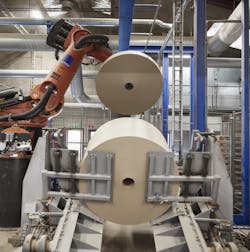Fueled by the Internet of Things (IoT) and real-time data from connected industrial equipment, companies are beginning to advance digital twin strategies to identify and fix bottlenecks, improve product quality, and garner production efficiencies in the virtual world without the time and cost constraints of planning and problem-solving using physical assets.
The definition of digital twin has, at times been murky, but with the push for more sensors and connected devices, the opportunities to leverage the rich, real-time operational data historically unavailable or locked away in siloed systems is becoming clear. To help clarify things, a digital twin, as defined by Gartner, is a digital representation of a real-world entity or system, and the implementation of a digital twin “is an encapsulated software object or model that mirrors a unique physical object, process, organization, person, or other abstraction.”
A key point differentiating a digital twin from a simulation is that a digital twin is connected to live, real-time data from the physical object it’s connected to and reacts correspondingly in real time.
Digital twins can model a single entity like a robotic arm or a specific quality process. However, the real power of a digital twin comes when manufacturers aggregate data from multiple digital twins to gain a holistic picture of a factory floor, warehouse or distribution center, field operation, or supply chain network, allowing them to generate real-time insights that lead to more productive and predictive actions.
A Gartner survey from 2019 found that 13% of organizations embarking on IoT projects already used digital twins while 62% were in the process or planning to do so—a trend line Gartner analysts said indicated digital twins were entering the mainstream. While supply chain disruptions and production halts during the height of the pandemic slowed the trajectory of digital twin implementations, Grandview Research is predicting significant growth—hitting $11.2 billion last year with an expected compound annual growth rate (CAGR) of 37.5% from 2023 through 2030.
A CapGemini Research Institute survey on digital twins shed more light on the impact of digital twin deployments for both top- and bottom-line benefits. Organizations working on digital twins have seen, on average, a 15% uptick in metrics such as sales, turnaround time, and operational efficiency, the CapGemini survey found. They’ve also seen improvements on the order of 25% for system performance and in some cases, enjoyed a 16% boost in sustainability.
There are myriad use cases for digital twins, but for now, most manufacturers are focused on boosting plant performance and productivity. Following are insights from three companies using digital twins that offer hints about what comes next.
Thermo Fisher Scientific
In the aftermath of the COVID pandemic, technologies used in the manufacturing of new vaccines and biologics are a hotbed of growth, and cell culture media is no exception. As part of a manufacturing expansion plan, Thermo Fisher Scientific enlisted an unlikely partner—a digital twin designed to pinpoint bottlenecks and highlight areas for improvement with an eye towards throttling up capacity on its high-profile, high-process cell culture media production lines.
To meet the surge in demand, the Thermo Fisher division moved into 24/7 operations, which eliminated the ability to leverage overtime to increase production. Before making any investment in additional capital equipment, the decision was made to leverage PTC ThingWorx industrial IoT (IIoT) platform and its Digital Performance Management (DPM) tool in a pilot digital twin project that would help maximize the capabilities of assets already in the factory, according to Dan Fallin, senior process manager at the company.
As the pilot started, the Thermo Fisher line operated at what Fallin described as a below middle-of-the-road overall equipment efficiency (OEE) score for like-sized companies. Using ThingWorx to capture real-time data from select plant floor assets and production processes and the DPM tool to analyze bottlenecks, Fallin’s team came close to its goal of doubling the OEE figure in less than six months.
Fallin attributes Thermo Fisher’s success to several factors. For one thing, he says it’s important to have strong IT/OT (operations technology) capabilities in place. “In our case, we had a lot of OT. It was a matter of going out and connecting them, which is why we’ve been successful in pulling information directly from the machine and not having to rely on human intervention,” he explains.
The team also maintains a very structured approach to performance management, working with a consulting firm at the onset to perform diagnostics and leveraging that same work pattern as it expands use of the digital twin to three additional sites planned for this year.
While the diagnostics provided a start, it was the DPM tool that really pinned down the problems. For example, an initial diagnostic of the overall process keyed in on a downstream process as the bottleneck; however, once DPM was employed, it determined the real problem to be changeovers occurring within a pacemaker system. Through even more exploration with DPM, the team determined the holdups were happening between lots—a common practice in pharmaceutical applications for sanitizing and other processes. “Now we’re getting more refined as to what issues are occurring between lots and getting more definition there,” Fallin says. “It is still evolving.”
Starting with performance management can ensure an expanded digital twin strategy has maximum impact on factory operations, contends James Zhang, vice president, market development, IoT Solutions at 0323.Skyynet.FINAL. “You need a digital twin of performance to tell you where the bottlenecks or constrained areas are in your factory,” Zhang explains. “Then you can analyze and use that knowledge to address the problem with the next-level digital twin.”
Skjern Paper
Based in Skjern, Denmark, Skjern Paper has long been an innovator, making 75,000 tons of paper and board products each year from 100% recycled fiber, including old newspaper. Quality of paper products was paramount, and plant management decided to stretch its innovation muscle by tapping into the latest technologies—AI/ML (artificial intelligence/machine learning), analytics, and an evolving digital twin—to take production and quality to the next level.
With the help of GE Digital, the Skjern team tapped Proficy CSense to create a digital twin for quality. The team constructed the CSense quality model, which draws from 20 data point inputs, around a parameter related to the Mullen burst strength of the paper, an industry standard test for measuring the paper’s physical strength and fiber bond.
“In general, manufacturers can get the most value from analytics by applying it to quality and throughput-related use cases,” says Corbus van Heerden, senior product manager, analytics, at GE Digital. Those particular use cases are directly tied to a company’s brand reputation as well as its ability to meet customer demand and deliver on other commitments, he adds.
Through use of the digital twin process models, Skjern has garnered critical insights, including that too much dewatering chemicals were being added to the production process, which resulted in scrap. As a result of these insights, they were able to reduce the amount of chemicals used, which decreased costs, cut down on scrap, and aided in the company’s sustainability efforts.
Erik Møller, Skjern Paper’s technical manager, advises companies to seek out relevant data to construct a robust data set, identify pilot projects to get started, and begin training team members. He says it’s important to get started with the team you have, not wait for specialized data scientists to start the digital twin journey.
“Process engineers have exceptional domain expertise to put together and interpret process models,” GE Digital’s van Heerden says. “This is the foundation for improving competitive advantage and success with analytics.”
CenterLine Limited
When deploying custom automated welding and assembly line equipment, the ability to catch and address any problems with robotics cells prior to factory floor installation is critical to delivering seamless operations.
CenterLine (Windsor) Limited, a family-owned Canadian business, turned to digital simulation and a virtual twin to optimize its robotics work cell designs prior to deploying physical equipment on its customers’ factory floors. Using Delmia Robotics on Dassault Systèmes’ 3DExperience platform to simulate products, processes, and factory operations, CenterLine was able to visualize and verify robot movements to optimize use of shop floor space, fine tune material flow, and ensure ergonomic safety.
CenterLine opted for the Delmia platform for its virtual twin journey in part because it could handle the wide range of robot brands it deploys. The software also enabled shop floor operators to create robot system programs on the factory floor without tying up physical resources, which has led to substantial time savings in the commissioning phase.
“The ease with which a user can add teaching points to a program allows us to create a program in a timely fashion,” Clayton says. “Once a path is taught in the simulation, the equipment can easily be moved around to find an optimal position. These efforts would take far too long and be very costly on the factory floor.”
When rolling out and evolving a digital twin strategy, the biggest challenge is always resistance to change along with some specific skills gaps, Clayton says. CenterLine has made a point to showcase the results of the digital twin and Delmia Robotics efforts to customers and plant floor personnel to help drive support. The company has also tapped Delmia training classes and created its own training resources to get its simulation team up to speed on digital twin skills.
Clayton underscores how important it is to continually share information and communicate the small wins of a virtual twin program as it progresses. “Discussing new technology, processes, and Delmia tools are not just an important process among digital twin users, but also with the manufacturing floor and end users of the machine,” Clayton says. “These discussions lead to new and innovative ideas that are implemented into the digital twin, and eventually the factory floor.”





